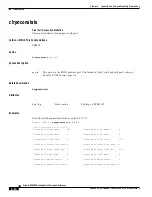
6-14
Cisco MGX 8850 Routing Switch Command Reference
Release 2.0, Part Number 78-10467-04 Rev C0, October 2001
Chapter 6
Logical Node, Port, and Signaling Commands
aesa_ping
aesa_ping
ATM End System Address Ping—ping any ATM end station connected to a PNNI network.
The aesa_ping command lets you ping an AESA based on an ATM address that you provide as a
destination address. If you specify only the destination address, the local node merely looks up that
address in its routing table. To actually confirm the reachability of another node, specify the optional
parameters for setting up a SVC to send and receive keep-alive packets.
Cards on Which This Command Runs
PXM45
Syntax
aesa_ping <destination address>
[-setupcall {yes/no} ]
[-qos {ubr | abr | cbr | vbr_rt | vbr_nrt}]
[-pcr {peak cell rate}]
[-scr {sustain cell rate}]
[-trace {yes/no}]
[-timeout {time out in secs}]
[-data {yes/no}]
[-interval {time}]
Syntax Description
destination
address
Destination address in NSAP format.
Example (the dots are optional):
47.00918100000000500ffde873.00500ffde873.01
Default: (none)
-setupcall
Sets up an SVC call as part of the ping. If you do not include the setupcall parameter,
the system performs only route lookup for the QoS parameters to the destination.
Possible values: yes or no
Default: no
-qos
Quality of service (QoS) used for SVC ping connection. This parameter applies only
if you enable setupcall. Possible values for QoS are: ubr, cbr, vbr, vbr-nrt, and vbr-rt
Default: ubr
-pcr
Peak cell rate of the ping. This parameter only applies if you enable setupcall.
Range: 1–100 cells per second
Default: 10
-scr
Sustained cell rate of the ping. This parameter applies only if you enable setupcall.
Range: 1–50 cells per second
Default: 5
















































